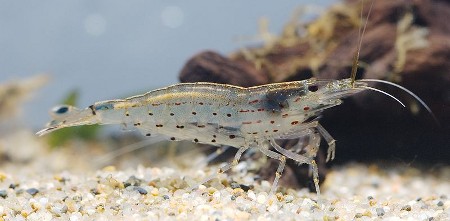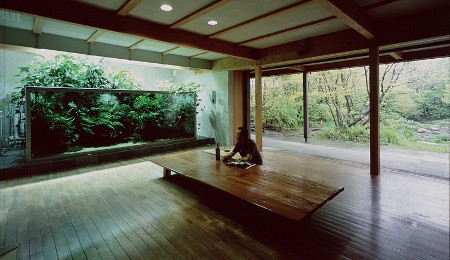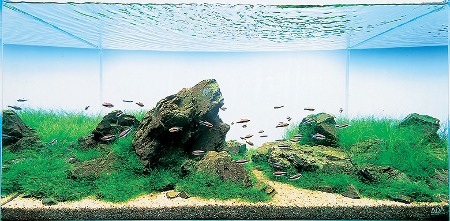| Interview with Takasi Amano At the end of `90 I came across a remarcable book: "Nature Aquarium World", which presented several scores of Takashi Amano aquariums. The visual impact was fantastic. It trampled on everything I knew at the time about aquascaping. It seemed an unachievable goal for an European, more accustomed with the classic Dutch style. That book won immediately an undefatigable admirer; like me – innumerable hobbysts all over the world...
1. A significant percent of all aquarists today (even aquascapers) has probably been "caught" by the hobby from little episodes, quite similar to those you shared with us, like the transport of your first colourful fish and some plants – inside a pair of fishing boots. Remembering those memories of your youth, can you tell us which were the steps of your road to success? Dream is what has led me here. I have had a dream since my childhood, and my passion comes from there. Today, many children in the world have fulfilled and comfortable life, which I did not have as I grew up. I did not have such life, but instead, I grew up closely with nature and my dream comes from this experience. For many years in Japan, economic growth was thought to be more important than keeping the natural environment. I had always felt perverse to such trend. Recently, people are starting to realize that we have been ignored nature for too long. My desire has not been fulfilled thus I still go after my desire today. 2.Takashi Amano aquascapes have made an impression right from the start with their personality, but also with the simplicity of several classic species, used to create some memorable aquascapes. During the `90s I understood that plants such as E.tenellus, Riccia, Microssorium, Glossostigma or various types of de Moss were the basis of the aquarium. What new plant species must be taken into account for the future Nature Aquarium set-ups? These days i like to use Lilaeopsis novae zelandiae and Hemianthus callitrichoides. The reason is because they grow slowly and does not need so much trimming. Also, they spred to hirizontal direction, making your layout composition rich. 3. Plants used in your presentation aquariums show perfect colours and health. Nevertheles, we don't know where these plants come from. Are these plants from your own production or, if not, what are your suppliers/group of suppliers of choice for populating the aquarium with aquatic plants? We have our plants, Wabikusa. We import from abroad and grow them at our site. We seldom get plants in Japan because Japanese plants are hard to grow in aquarium tank. 4. Each plant has its own requirements. However, what are, in your opinion, the optimal parameters of a Nature aquarium, populated with plants of the same type you frequently use (Microssorium, Glossostigma, Bolbitis, Riccia of various types of Moss)? I'm talking about Temperature, Ph, Gh, KH, No2, No3, CO2 etc.. This depends on each tank and its condition, so there is no standardized value. However, I personally prefer soft water, pH 6 (under 7), degree of hardness 1 ~ 3 (dH). 5. The illumination of normally planted aquariums is usually done using fluorescent tubes or HQI/HQL lamps. Generally, European producers recommend a minimum of 6500K in order to stimulate photosyntesis, lights over 10000K being dedicated to marine aquariums. As I concluded after reading several articles, ADA recommends levels around 8000-8500K. What led you to choose this range? As you may know, as kelvin value increases, the light turns more blue, which means it transmit water more. Plants generally do photosynthesis in red color, but i think water plants has adjusted themselved to grow more in blue color. 6. An already classic pattern by Mr. Takasi Amano, for planted aquariums, is to populate the tank with Caridina multidentata/Caridina japonica (Takashi Amano shrimp), Otocinclus and Paracheirodon axelrodi. Are you still a fan of this popular pattern or have discovered along the years another succesfull “triumvirate”? What you mentioned maybe classic, but I have also created many combinations. So, fishes and plants I use depend on the layout. If it is Iwagumi layout, I prefer to have cardinals, and if it is driftwood layout, I like to have plants growing and fluttery fishes. 7. Speaking about the Amano shrimp, whose utility is largely appreciated by all aquarists with a preference for planted aquariums, but…whose reproduction is, at least for us, Romanians, rather mysterious. There is a legend, according to which, this shrimp can be reproduced at industrial scale only by concessioning a river that feeds a brackish water, the parameters of which help at a good development and evolution from larvae to adult stage, similar to River Yamato. How much truth is there? Yes, it is TRUE! There are two kinds of reproduction systems in shrimps and Caridina japonica belong to the ones you mentioned as mysterious (other types are like Red Bee Shrimps, they have eggs). I do not really sure about River yamato thoguh.  8. In the last few years, we can see at various international contests that many new aquascapers try to create layouts that are a little bit out of the strict “Nature aquarium” style. What do you think about the present trend in aquascaping? Can you predict these tendencies to keep on a long term basis, or will they shortly switch to a dramatically new direction? Can we talk about fads in aquascaping? There are many layout seems to be made just for the contest and to take a photograph. They are created and broken down in half year to one year span. And of course there is nothing wrong with it. It may be one way to enjoy Nature Aquarium for some aquarists. But in my opinion, a good layout can be maintained for a long period of time and has mutual-beneficial (in Japanese, we shave a term, kyozon-Kyoei) environment for all organisms in the tank. A good aquascaper should be able to create such layout as it needs quite some techniques. In that sense, we have not seen a perfect layout. 9. Dutch style tanks don’t win anymore international contests because they look too artificial and too ”clean”. At the same time, some of the” Nature aquariums” present a somewhat “wishful thinking” pictures of the underwater places. Unfortunately nature biotope doesn’t look at all like a “Nature aquarium”. Where is the truth, is it possible a mixture between the two main concepts? Sure it is possible. I believe that there are many possibilities in Nature Aquarium, rather than having just a typical style. It is up to the aquascaper how he/she makes the layout. And it is possible to win a contest with such layout, I believe. In Nature Aquarium, one should explore and freely express what they feel. 10. We have all got used, when we speak of aquascapes or Nature aquariums, to think about aquariums with biologic material adequate for tropical aquariums. Have you tried reef aquaristic? Do you think there could be done something similar to your works, but in marine aquaristic? Sure, it is possible. We have one marine aquarium in our gallery. But to create more, I simply do not have time now! 11. Se stie ca sunteti in egala masura si un pasionat landscape photographer al "Untouched precious natural landscape". Stiu ca obisnuiati sa lucrati cu Deardorff large cameras a caror productie (daca nu ma insel) a fost sistata undeva la sfarsitul anilor 80. De atunci au aparut o multime de aparate cu performante remarcabile, la preturi accesibile. Care ar fi o camera foto DSRL/obiectiv, cu un raport decent pret/calitate, pe care ati recomanda-o pentru un acvarist ce vrea sa-si pozeze acvariul la un International Aquatic Plants Layout Contest (ADA contest), dar care ar prefera sa investeasca totusi mai mult in acvariul sau decat in camera foto? I used to stick to film cameras, but now I see some good digital cameras. It is hard to name one, but I use Cannon EOS 50D 272 sometimes to take general photographs. But I would say it is essential to use tripod. 12. ADA products have been appreciated for years in Romania, even if they have not been officially distributed so far. Your experience and achievments made us look for ADA distributors from the neighbouring countries, with whom, however, we collaborate and communicate rather slowly. However, encouraged by the relationships we noticed you have with similar partners in Hungary or by the recent visit to Poland, could we hope for a more tight relationship with Romania, a possible future visit/course in our country? If you request, I would be happy to go to Romania as I see myself as a preacher of Nature Aquarium. 13. And, to close this interview you graciously granted us, are there any other things you might wish to say to our Romanian readers in order to give one advice to set-up his or her first nature aquarium, what would it be? I would like to say to Romanian readers that I was not successful from the beginning. I have put a lot of effort. Nothing was easy, but I kept trying. So, I would like Romanian hobbyists to never give up and keep trying to make a better layout. If you continue, you will get better. Also, it is very important to always keep in your mind that you are treating life, so “Do not waste LIFE.” In terms of environment, the situation will not get significantly better, but it will only get worse. But I think that having Nature Aquarium around you is similar to the attitude of conservation act. Nature Aquarium is a very good tool to learn about ecosystem and it requires combined knowledge of biology, chemistry and physics. So in other words, a person who creates Nature Aquarium is a person who creates natural environment. I hope that those people become a frontier to enlighten and environmental issue and importance of nature. With such acts, Nature Aquarium as a hobby will contribute to the society and gain social respectability, too.
Mr. Takashi Amano Takashi Amano was born in 1954 in Niigata, Japan. He has explored the remote jungles of South America and Africa and photographed a vast amount of nature scenes during his 16-year career as professional cyclist. He continued his research of tropical fish husbandry and aquatic plant cultivation and put forth an aquatic plant layout method, “Nature Aquarium,” which combines his extensive experience in the observation of nature and his unique sense of beauty. In his own style of plant layout, plants, fishes and microorganisms cohabit and create an ecological system in an aquarium tank; plants absorb CO2, photosynthesize and produce oxygen, and this rich oxygen creates the best environment for fishes and microorganism. He founded Aqua Design Amano Co., Ltd. in 1982 and became attention for its development of aquatic plant growing equipments, "Nature Aquarium Goods". Mr. Takashi was awarded the silver medal of the Fuji Film Nature Photo Contest in 1991, and the Grand Prix of the same contest in 1992. He has also won many awards in various photo contests, and has authored many books. He established Aqua Design Amano (ADA) Co., Ltd. in 1993, of which he is the president and CEO. AmanoTakashi.net - His information and photographic portfolio. Acest interviu a fost realizat pentru acvariu.ro de Alex Veres.. |




 PHONE: 021.320.20.88 FAX: 021.320.20.02
PHONE: 021.320.20.88 FAX: 021.320.20.02